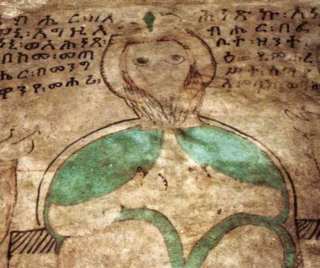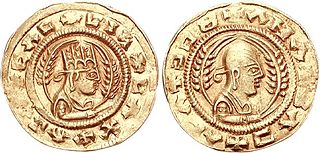This is a list of monarchies of Ethiopia that existed throughout the nation's history. It is divided into kingdoms that were subdivisions of Ethiopia, and kingdoms that were later conquered by Ethiopia. Ancient kingdoms fall into neither category.
This is a list of monarchies of Ethiopia that existed throughout the nation's history. It is divided into kingdoms that were subdivisions of Ethiopia, and kingdoms that were later conquered by Ethiopia. Ancient kingdoms fall into neither category.
Kingdom of Zion (consisting of Tigray, Gondar, Gojjam, and Semien) under King ( Negus ) Mikael of Wollo 1914 - 1916
The following polities are unidentified kingdoms or chiefdoms, and are not mentioned in standard references:

The emperor of Ethiopia, also known as the Atse, was the hereditary ruler of the Ethiopian Empire, from at least the 13th century until the abolition of the monarchy in 1975. The emperor was the head of state and head of government, with ultimate executive, judicial and legislative power in that country. A National Geographic article from 1965 called imperial Ethiopia "nominally a constitutional monarchy; in fact [it was] a benevolent autocracy".

The Solomonic dynasty, also known as the House of Solomon, was the ruling dynasty of the Ethiopian Empire from the thirteenth to twentieth centuries. The dynasty was founded by Yekuno Amlak, who overthrew the Zagwe dynasty in 1270. His successors claimed he was descended from the legendary king Menelik I, the supposed son of the biblical King Solomon and the Queen of Sheba, in order to legitimize the dynasty's assumption of power. Although this claimed ancestry gave the dynasty its name, there is no credible evidence that the dynasty was descended from Solomon or the Davidic line. The Solomonic dynasty remained in power until 1974, when its last emperor Haile Selassie was overthrown by a coup d'état.

The Zagwe dynasty was an Agaw medieval dynasty that ruled the northern parts of Ethiopia and Eritrea, after the historical name of the Lasta province. Centered at Roha, it ruled large parts of the territory from approximately 900 to 1270 CE, when the last Zagwe King Za-Ilmaknun was killed in battle by the forces of the Amhara King Yekuno Amlak. The name of the dynasty is thought to derive from the ancient Ge'ez phrase Ze-Agaw, meaning "of the Agaw", in reference to the Mara Tekle Haymanot, the founder of the dynasty. Zagwe's best-known King was Gebre Mesqel Lalibela, who is credited with having constructed the rock-hewn monolithic churches of Lalibela.

Yekuno Amlak ; throne name Tesfa Iyasus was Emperor of Ethiopia, from 1270 to 1285, and the founder of the Solomonic dynasty, which lasted until 1974. He was a ruler from Bete Amhara who became the Emperor of Ethiopia following the defeat of the last Zagwe king.

MotiAbba Jifar II was King of the Gibe Kingdom of Jimma.

The Kingdom of Jimma was an Oromo kingdom in the Gibe region of Ethiopia that emerged in the 18th century. It shared its western border with Limmu-Ennarea, its eastern border with the Sidamo Kingdom of Janjero, and was separated from the Kingdom of Kaffa to the south by the Gojeb River. Jimma was considered the most powerful militarily of the Gibe kingdoms.
The Gibe region was a historic region in modern southwestern Ethiopia, to the west of the Gibe and Omo Rivers, and north of the Gojeb. It was the location of the former Oromo and Sidama kingdoms of Gera, Gomma, Garo, Gumma, Jimma, and Limmu-Ennarea.

The Kingdom of Gomma was a kingdom in the Gibe region of Ethiopia that emerged in the 18th century. It was based in Agaro.

The Kingdom of Limmu-Ennarea was one of the kingdoms in the Gibe region of Ethiopia that emerged in the 19th century. It shared its eastern border with the Kingdom of Jimma, its southern border with the Kingdom of Gomma and its western border with the Kingdom of Gumma. Beyond its northern border lay tribes of the Macha Oromo. Jimma was considered the most civilized of the Gibe kingdoms, which had a population in the 1880s between 10,000 and 12,000. It was converted to Islam by missionaries from Harar in the first half of the 19th century; C.T. Beke, writing in 1841, reported that its "king and most of his subjects are Mohammedan." Limmu-Ennarea's capital was at Saqqa.
The Kingdom of Garo, also known as Bosha after its ruling dynasty, was an Oromo-Sidama kingdom in the Horn of Africa. Established by the Sidama people, it was situated on the periphery of the Gibe region of Ethiopia.

The Kingdom of Kaffa was a kingdom located in what is now Ethiopia from 1390 to 1897, with its first capital at Bonga. The Gojeb River formed its northern border, beyond which lay the Gibe kingdoms; to the east the territory of the Konta and Kullo peoples lay between Kaffa and the Omo River; to the south numerous subgroups of the Gimira people, and to the west lay the Majangir people. The native language, also known as Kaffa, is one of the Omotic group of languages.

Princess Mahisente Habte Mariam(born at Nekemte on 9 February 1937) is the widow of Prince Sahle Selassie, youngest son of Emperor Haile Selassie of Ethiopia. She is the daughter of Dejazmach Habte Mariam Gebre-Igziabiher, also referred as Kumsa Moroda heir to the former Welega Kingdom of Leqa Naqamte, and later served as governor of Welega province. Her mother was Woizero Yeshimebet Guma, grand daughterof Moti Joté Tulu of Wesstern Welega]] [Oromo people|Oromo]] noblewoman who was later married to Ras Mesfin Selashi, a leading Ethiopian aristocrat and close associate of Emperor Haile Selassie. Princess Mahisente is also the mother of Prince Ermias Sahle Selassie, the current President of the Crown Council of Ethiopia.
This is a list of rulers and office-holders of Ethiopia.
The following is a list of the political history of East Africa.

The architecture of Ethiopia varies greatly from region to region. Over the years, it has incorporated various architectural styles and techniques.

Ethiopia is one of the oldest countries in Africa; the emergence of Ethiopian civilization dates back thousands of years. Abyssinia or rather "Ze Etiyopia" was ruled by the Semitic Abyssinians (Habesha) composed mainly of the Amhara and Tigray, the Cushitic Agaw. In the Eastern escarpment of the Ethiopian highlands and more so the lowlands was the home of the Arab-descended Harari that founded Sultanates such as Ifat and Adal and the Afars. In the central and south were found the ancient Sidama and Semitic Gurage, among others.

The Kingdom of Aksum, also known as the Kingdom of Axum, the City-State of Axum, or the Aksumite Empire, was centered in East Africa and South Arabia from Classical antiquity to the Middle Ages. Based primarily in what is now northern Ethiopia, and spanning modern-day Eritrea, Djibouti and Sudan, it extended at its height into much of Southern Arabia during the reign of Kaleb, King of Axum.

The Makhzumi dynasty also known as Sultanate of Shewa or Shewa Sultanate, was a Muslim kingdom in present-day Ethiopia. Its capital Walale was situated in northern Hararghe in Harla country. Its territory extended possibly to some areas west of the Awash River. The port of Zeila may have influenced the kingdom. The rise of the Makhzumi state at the same time resulted in the decline of the Kingdom of Axum. Several engravings dating back to the 13th century showing the presence of the kingdom are found in Chelenqo, Bate, Harla near Dire Dawa and Munessa near Lake Langano.

Ennarea, also known as E(n)narya or In(n)arya, was a kingdom in the Gibe region in what is now western Ethiopia. It became independent from the kingdom of Damot in the 14th century and would be the most powerful kingdom in the region until its decline in the 17th century. Being located on the southwestern periphery of the Ethiopian Empire, Ennarea was its tributary throughout much of its history, supplying the emperor with gold and slaves. The culmination of this relationship was the Christianization of the Ennarean elite in the late 1580s. From the late 16th century the kingdom came under increasing pressure by the Oromo, who finally conquered Ennarea in around 1710.